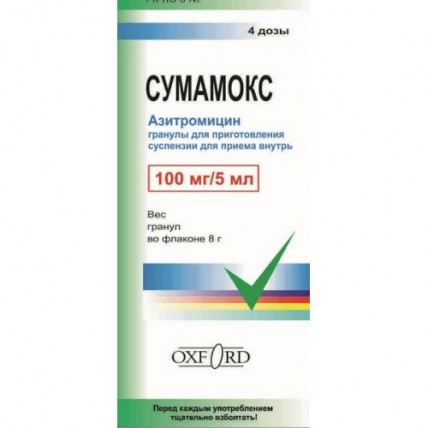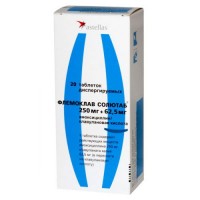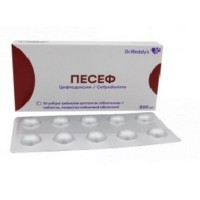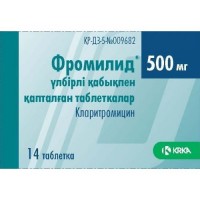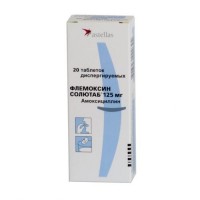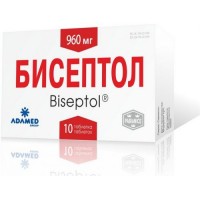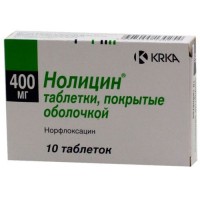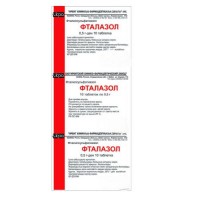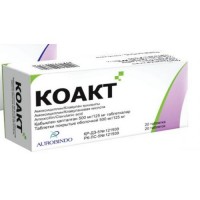Sumamoks 100 mg / 5 ml, 8g granules for oral suspension
- $10.30
The instruction for medical use of Sumamoks Torgovoye medicine a name of Sumamoks the International unlicensed name Azithromycin Dosage Form of the Granule for preparation of suspension for intake, 100 mg / 5 ml and 200 mg / 5 ml Structure of 5 ml of suspension contains 100 mg / 5 ml 200 mg / 5 ml active agent – azithromycin of a dihydrate of 104.82 mg 209.625 mg (it is equivalent to azithromycin) (100.0 mg) (200.0 mg) excipients: sucrose, sodium carboxymethylcellulose, gum xanthane, sodium phosphate trekhosnovny dodecahydrate, sodium lauryl sulfate, Natrium benzoicum, sodium chloride, Ponso 4R, fragrance cherry, silicon dioxide colloidal. The description the Granulated powder of light pink color with a characteristic cherry smell. The restored suspension of pink color with a characteristic cherry smell. Pharmacotherapeutic group Antibacterial drugs for system use. Macroleads, linkozamina and streptogramina. Macroleads. Azithromycin. The ATX J01FA10 code the Pharmacological Pharmacokinetics Absorption Later properties of intake azithromycin is quickly soaked up. Linking of azithromycin with proteins of plasma varies depending on concentration and decreases from 51% at 0.02 mkg/ml to 7% at 2 mkg/ml. Distribution Azithromycin is widely distributed on all organism. Fast distribution of azithromycin in fabrics and high intracellular concentration provides higher concentration of drug in fabrics, than in plasma or serum. Metabolism and removal Removal of azithromycin from blood plasma happens in 2 stages: elimination half-life (T1/2) makes 14-20 h in the range from 8 h up to 24 h after administration of drug and 41 h – in the range from 24 h up to 72 h that allows to use drug of 1 times/days. Drug generally with bile in not changed look is emitted, a small part is removed by kidneys. The pharmacodynamics Active agent of the drug Sumamoks - azithromycin is an antibiotic of a broad spectrum of activity, the first representative of new subgroup of makrolidny antibiotics – azaleads. Sumamoks possesses bacteriostatic action, but during creation in the center of inflammation of high concentrations causes bactericidal effect. Sumamoks suppresses synthesis of protein in sensitive microorganisms, showing activity concerning the majority of strains of gram-positive, gram-negative, anaerobic, intracellular and other microorganisms: Mycoplasma pneumoniae, Haemophilus ducreyi, Moraxella catarrhalis, Propionibacterium acnes, Gardnerella vaginalis, Actinomyces species, Bordetella pertussis, Borrelia burgdorferi, Mobiluncus species, Haemophilus influenzae, Streptococcus pyogenes, Haemophilus parainfluenzae, Streptococcus pneumoniae, Legionella pneumophila, Streptococcus agalactiae, Neisseria meningitides, Streptococcus viridans, Neisseria gonorrhoeae, Streptococcus group C, F, G, Helicobacter pylori, Peptococcus species, Campylobacter jejuni, Peptostreptococcus, Pasteurella multocida, Fusobacterium necrophorum, Pasteurella haemolytica, Clostridium perfringens, Brucella melitensis, Bacteroides bivius, Bordetella parapertussis, Chlamydia trachomatis, Vibrio cholerae, Chlamydia pneumoniae, Vibrio parahaemolyticus, Ureaplasma urealyticum, Plesiomonas shigelloides, Listeria monocytogenes, Staphylococcus epidermidis, Staphylococcus aureus * (*эритромицин – a sensitive strain), Escherichia coli, Bacteroides fragilis, Salmonella enteritidis, Bacteroides oralis, Salmonella typhi, Clostridium difficile, Shigella sonnei, Eubacterium lentum, Yersinia enterocolitica, Fusobacterium nucleatum, Acinetobacter calcoaceticus, Aeromonas hydrophilia. Indications - upper respiratory tract infections (bacterial pharyngitis / tonsillitis, average otitis) - lower respiratory tract infections (bacterial bronchitis, interstitial and alveolar pneumonia, exacerbation of chronic bronchitis) - infections of skin and soft tissues (the chronic migrating erythema – an initial stage of a disease of Lyme, an ugly face, impetigo, secondary pyodermatoses) - infections of an urogenital path (gonorrheal and not gonorrheal urethritis and/or a cervicitis) the Route of administration and doses of the Instruction on suspension preparation. At first to loosen powder, well stirring up a bottle, then to add svezhekipyacheny chilled water to a tag (20 ml) of a bottle to receive 4 doses of the suspension containing 100 mg and 200 mg of azithromycin in 5 ml of suspension. To carefully shake up bottle contents before formation of uniform homogeneous suspension. After preparation, suspension of pink color will be received. Sumamoks suspension before the use should be shaken up. To accept suspension inside a spoon doser of 2.5/5.0 ml. After intake of suspension to drink a small amount of water to wash away and swallow the suspensions which remained quantity in an oral cavity. To use Sumamoks suspension within 5 days after preparation. Sumamoks suspension should be accepted in 1 hour prior to food or in 2 hours after a meal. Sumamoks it is not necessary to accept together with food. The adult (including elderly people), to children 12 years and with a body weight over 45 kg are more senior. Treatment of exacerbations of chronic obstructive pulmonary diseases, light and moderate severity, community-acquired pneumonia, pharyngitis and tonsillitis (as therapy of the second row), and the uncomplicated infections of skin and soft tissues caused by sensitive microorganisms on 500 mg (25 ml 100 mg / 5 ml of a dosage or 12.5 ml 200 mg / 5 dosage ml) 1 time in the first day, then on 250 mg (12.5 ml 100 mg / 5 ml of a dosage or 6.25 ml 200 mg / 5 dosage ml) from the 2nd to the 5th day. Treatment of ulcer diseases of genitals at men (shankroid), the caused Haemophilus ducreyi, not gonococcal urethritis and a cervicitis caused by C. trachomatis: single dose of 1 g (50 ml 100 mg / 5 ml of a dosage, 25 ml 200 mg / 5 dosage ml). Treatment of an urethritis and cervicitis, the caused Neisseria gonorrhoeae: single dose of 2 g (100 ml 100 mg / 5 ml of a dosage, 50 ml 200 mg / 5 dosage ml). The maximum single dose for adults: 2 g (100 ml 100 mg / 5 ml of a dosage, 50 ml 200 mg / 5 dosage ml). The maximum daily dose for adults: 2 g (100 ml 100 mg / 5 ml of a dosage, 50 ml 200 mg / 5 dosage ml). To children 12 years for treatment of pharyngitis or tonsillitis are more senior: 12 mg/kg once a day within 5 days. Maximum single dose for children over 12 years: 1.5 g (75 ml 100 mg / 5 ml of a dosage, 37.5 ml 200 mg / 5 ml of a dosage). Maximum daily dose for children over 12 years: 1.5 g (100 ml 100 mg / 5 ml of a dosage, 37.5 ml 200 mg / 5 ml of a dosage). Children with a body weight up to 45 kg. For children who weigh more than 15 kg suspension of azithromycin has to be is accepted with the help by a spoon - the doser which provides 2.5 or 5 ml of doses, respectively 100 or 200 mg of azithromycin, according to the following mode of dosing: The weight (kg) 3-day treatment * the 5th day treatment * 10-15 Once a day in a dose of 10 mg/kg from 1st to the 3rd day Once a day in a dose of 10 mg/kg in the first day, then once a day 5 mg/kg from the 2nd to the 5th day. 16-25 Once a day on 200 mg (5 ml) from 1st to the 3rd day Once a day on 200 mg (5 ml) in the first day, and then once a day 100 mg (2.5 ml) from the 2nd to the 5th day. 26-35 Once a day 300 mg (7.5 ml) from 1st to the 3rd day Once a day 300 mg (7.5 ml) in the first day, and then once a day in a dose of 150 mg (3.75 ml) from the 2nd to the 5th day. 35-45 Once a day on 400 mg (10 ml) from 1st to the 3rd day Once a day on 400 mg (10 ml) in the first day, and then once a day on 200 mg (5 ml) from the 2nd to the 5th day. & gt, 45 Doses as for adults * Separate recommendations about Sumamoks's dosage at streptococcal pharyngitis are described below. For treatment of streptococcal pharyngitis at children at the age of 2 years is also more senior azithromycin in a single dose of 10 mg/kg or 20 mg/kg within three days is applied, at the same time not to exceed the maximum daily dose of 500 mg (25 ml 100 mg / 5 ml of a dosage, 12.5 ml 200 mg / 5 dosage ml). However, penicillin remains the first choice of treatment of streptococcal pharyngitis as prevention of acute rheumatism. Separate groups of patients Advanced age is not required for patients of advanced age of correcting of a dose. Patients with a renal failure the Dose adjustment is not necessary from patients with a slight and moderate renal failure (KK of 10 - 80 ml/min.) Patients with a liver failure the Dose adjustment is not required for patients from easy and moderated by abnormal liver functions (class A or B). Side effects Often - nausea, vomiting, diarrhea, abdominal pains / spasms Infrequently - dizziness / vertigo, a headache, spasms, drowsiness, an asthenia, an indisposition - a liquid chair, a meteorism, a digestive disturbance, anorexia - an itching, skin rashes, hypostases - a stethalgia, an arthralgia Seldom - thrombocytopenia, a neutropenia, hemolytic anemia, a leukopenia, an eosinophilia - paresthesia, an asthenia, insomnia, hyperactivity, aggression, concern, nervousness, at elderly depersonalization, consciousness disorders, uneasiness - sonitus, a reversible hearing disorder up to deafness (at reception of high doses for a long time), disturbance of perception of taste and a smell, a disorder of vision, decolouration of teeth - heartbeat, arrhythmia, ventricular tachycardia, increase in an interval QT, bidirectional ventricular tachycardia, hypotonia, a hyperpotassemia - a constipation, discoloration of language, pseudomembranous colitis, cholestatic jaundice, hepatitis, change of laboratory indicators (increase in ALT, nuclear heating plant, bilirubin level) of function of a liver, pancreatitis, gastritis - a Quincke's disease, a small tortoiseshell, a photosensitization, anaphylactic reaction, including hypostasis (in rare instances from the death), a mnogoformny erythema, Stephens's syndrome - Johnson, a toxic epidermal necrolysis - nephrite, an acute renal failure, increase in level of urea, creatinine - a vaginitis, candidiasis Very seldom - a liver failure, fulminantny necrosis of a liver (it is possible from the death) Contraindications - hypersensitivity to azithromycin, erythromycin and any other antibiotics of group of macroleads or to any other components of drug - heavy abnormal liver functions and kidneys - patients with rare hereditary intolerance of fructose, malabsorption of glucose galactose or insufficiency of sucrose - isomaltoses - pregnancy - the lactation period Medicinal interactions of Sumamoks affects activity of enzymes of a complex of R-450 cytochrome and unlike other macroleads, interaction with theophylline, carbamazepine, triazolamy is noted now. At joint prescribing of warfarin and azithromycin (in usual doses) change of a prothrombin time is not revealed, however considering that in interaction of macroleads and warfarin strengthening of anticoagulating effect is possible, careful control of a prothrombin time is necessary for patients. Ergotamine and dihydroergotamine: strengthening of toxic action (vasospasm, dizesteziya). Antacids When studying pharmacokinetics at combined use of an antacid with azithromycin, the general change in bioavailability was not observed though at measurement of the maximum plasma concentration of azithromycin, reduction of concentration by 25% was observed. Sumamoks it is necessary to accept, at least, in 1 hour prior to or in 2 hours after antacids. Tsetirizin At healthy volunteers, with tsetirizin 20 mg did not lead combined use of azithromycin to pharmacokinetic interactions and any significant changes in QT interval. Use of macroleads with digoxin led digoxin At some patients to disturbance of metabolism of digoxin in intestines. Therefore, combined use of azithromycin and digoxin can lead to increase in concentration of digoxin, due to weakening of its inactivation indestinal flora. The zidovudine of 1000 mg and 1200 mg of a single dose or 600 mg of several doses of azithromycin has small influence on pharmacokinetics of a zidovudine or on its metabolite of a glucuronide in plasma or on excretion with urine. Didanozin (didezoksiinozin) Combined use of azithromycin and a didanozin does not influence pharmacokinetics of a didanozin. Pri's cyclosporine combined use of azithromycin and cyclosporine is observed increase in concentration of cyclosporine and PPFK-5. In need of joint appointment, it is necessary cyclosporine dose adjustment. Nelfinavir Pri combined use of azithromycin and a nelfinavir is observed increase in concentration of a nelfinavir. Clinically significant side effects were not observed and dose adjustment is not required. Tsizaprida Tsizaprid is metabolized in a liver by means of CYP3A4 enzyme. Macroleads brake this enzyme therefore combined use of a tsizaprid and azithromycin can cause extension of an interval of QT, ventricular arrhythmia and torsade de pointes. The substances extending an interval QT Azithromycin should not be applied together with other active agents extending QT interval. Special instructions Elderly patients and patients with heart diseases can be more susceptible to aritmogenny effects of an antibiotic. Pri emergence of symptoms of hepatitis, Sumamoks's reception has to be stopped immediately. Pri emergence of allergic reactions, Sumamoks has to will be cancelled immediately and the corresponding therapy has to be begun. Sumamoks with care it is appointed the patient with warmly vascular pathology. Patients of high risk at whom the extended QT interval was noted earlier a hypopotassemia, a hypomagnesiemia and bradycardia have to be carefully consulted by the doctor. Sumamoksa contains sucrose. Content of sucrose should be considered at patients with diabetes. Allergic reactions In rare instances azithromycin can cause serious allergic reactions, such as Quincke's disease and anaphylaxis. The renal failure At patients with a slight and moderate renal failure (SKF of 10 - 80 ml/min.) dose adjustment is not necessary. The care at appointment as the patient with a heavy renal failure is recommended (SKF & lt, 10 ml/min.). The liver failure As a liver is the main way of removal of azithromycin, Sumamoks's use should be carried out with care at patients with a considerable disease of a liver. In case of signs and symptoms of an abnormal liver function, such as fast development of an asthenia the connected with jaundice, dark urine, tendency to bleedings or hepatic encephalopathy, have to be immediately executed laboratory researches of function of a liver. Pri of liver dysfunction azithromycin has to stop immediately. It is necessary to take into account, before Sumamoks's appointment: Sumamoks in suspension for oral administration is not suitable for treatment of heavy infections where fast increase in concentration of an antibiotic in blood is necessary. Prescribing of azithromycin and other antibiotics it is important to Pri to consider a disease caused by activators, resistant to erythromycin. As for other macroleads high levels of resistance to Streptococcus pneumoniae (& gt, 30%) for azithromycin were received. It has to be taken into account at treatment of the infections caused by Streptococcus pneumoniae. The main contagium of soft tissues, golden staphylococcus, is often steady to azithromycin. Thus, testing for sensitivity to azithromycin is considered a prerequisite for treatment of an infection of soft tissues. Pharyngitis / tonsillitis of Sumamoks is not substance of the first choice for treatment of the pharyngitis and tonsillitis caused by Streptococcus pneumoniae. For this purpose and for prevention of acute rheumatic fever penicillin is the first drug of the choice. Sinusitis of Sumamoks is not substance of the first choice for treatment of sinusitis, acute average otitis. Superinfections It is necessary to pay attention to possible symptoms of superinfection the caused insensitive activators, such as mushrooms. Superinfection can demand the treatment termination by azithromycin and the appropriate measures are taken. The patients having neurologic or psychiatric diseases should appoint neurologic or psychiatric diseases of Sumamoks with care. A myasthenia there Were cases emergence of a symptom of a myasthenia and aggravation of symptoms of a myasthenia in the patients receiving azithromycin. The diarrhea associated with Clostridium difficile Diarrhea, associated with Clostridium difficile (DAKD) is shown practical in all cases of use antib
kterialny means, including Sumamoks, and can vary on weight from slight diarrhea to fatal colitis. Treatment by antibacterial agents changes normal flora of a large intestine and leads to Clostridium difficile overgrowth the Prolonged use Safety and efficiency of prolonged use of azithromycin for the specified indications is not known. In case of a fast recurrent infection, treatments with other antibiotics have to be considered. Safety of azithromycin for children aged up to 6 months it is not established. Safety and efficiency of azithromycin for prevention or treatment of the Complex of Yellow Bacilli (CYB) at children are not established. Features influence of drug on ability to run transport or potentially dangerous mechanisms Considering side effects of medicine, it is necessary to be careful at control of motor transport and other potentially dangerous mechanisms Overdose Symptoms. Reversible hearing losses, severe nausea, vomiting and diarrhea. Treatment. In case of overdose, activated carbon is appointed or to wash out a stomach and to appoint the general symptomatic treatment in case of need. A form of release and packing On 8.0 g (for 100 mg / 5 dosage ml) and 13.0 g (for 200 mg / 5 dosage ml) drug in bottles of 40 ml from brown glass with a tag of 20 ml, corked by the rubber bung which is pressed out by an aluminum cap and a polypropylene cover. On each bottle paste the label. On 1 bottle together with a spoon doser of 2.5/5.0 ml and the instruction for medical use in the state and Russian languages place in a pack from cardboard. Storage conditions In dry in the place protected from light, at a temperature not over 25 of 0C. The prepared suspension is stored at a temperature from 15 °C to 25 °C no more than 5 days to Store out of children's reach! 2 years not to apply a period of storage after the expiry date specified on packing. Prescription status According to the prescription Laboratories Pvt. Ltd Oxford Producer, B306, Christal Plaza, New Link Road, Andheri (Vest), Mumbai, India the Owner of the registration certificate Oxford Laboratories Pvt. Ltd, India the Address of the organization accepting in the territory of the Republic of Kazakhstan claims from consumers on quality of products (goods) Representation Oxford Laboratories Pvt., Ltd. Almaty, Auyezov St. 3 Ph./fax + 7 727 266 95 50 E-mail:
To Develop almatyoxford@hotmail.com
kterialny means, including Sumamoks, and can vary on weight from slight diarrhea to fatal colitis. Treatment by antibacterial agents changes normal flora of a large intestine and leads to Clostridium difficile overgrowth the Prolonged use Safety and efficiency of prolonged use of azithromycin for the specified indications is not known. In case of a fast recurrent infection, treatments with other antibiotics have to be considered. Safety of azithromycin for children aged up to 6 months it is not established. Safety and efficiency of azithromycin for prevention or treatment of the Complex of Yellow Bacilli (CYB) at children are not established. Features influence of drug on ability to run transport or potentially dangerous mechanisms Considering side effects of medicine, it is necessary to be careful at control of motor transport and other potentially dangerous mechanisms Overdose Symptoms. Reversible hearing losses, severe nausea, vomiting and diarrhea. Treatment. In case of overdose, activated carbon is appointed or to wash out a stomach and to appoint the general symptomatic treatment in case of need. A form of release and packing On 8.0 g (for 100 mg / 5 dosage ml) and 13.0 g (for 200 mg / 5 dosage ml) drug in bottles of 40 ml from brown glass with a tag of 20 ml, corked by the rubber bung which is pressed out by an aluminum cap and a polypropylene cover. On each bottle paste the label. On 1 bottle together with a spoon doser of 2.5/5.0 ml and the instruction for medical use in the state and Russian languages place in a pack from cardboard. Storage conditions In dry in the place protected from light, at a temperature not over 25 of 0C. The prepared suspension is stored at a temperature from 15 °C to 25 °C no more than 5 days to Store out of children's reach! 2 years not to apply a period of storage after the expiry date specified on packing. Prescription status According to the prescription Laboratories Pvt. Ltd Oxford Producer, B306, Christal Plaza, New Link Road, Andheri (Vest), Mumbai, India the Owner of the registration certificate Oxford Laboratories Pvt. Ltd, India the Address of the organization accepting in the territory of the Republic of Kazakhstan claims from consumers on quality of products (goods) Representation Oxford Laboratories Pvt., Ltd. Almaty, Auyezov St. 3 Ph./fax + 7 727 266 95 50 E-mail:
To Develop almatyoxford@hotmail.com
